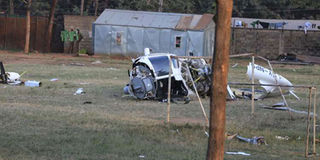Stop endless deaths on our roads and airspace

A police helicopter that crashed at the National Youth Service headquarters in Ruaraka, Nairobi on September 8,2016. PHOTO | WILLIAM OERI | NATION MEDIA GROUP
What you need to know:
- Tragedies tend to affect those who are fit and healthy with much of their life still to live.
They therefore rob people of their futures and leave family and friends bereft and in shock.
Last week, my dear friend, Berenika Stefanska, died in a plane crash in Naivasha. The pilot, George Aggett, later succumbed to his injuries. I did not know George, but my heart goes out to his family and friends, and to Berenika’s.
I am incapable of capturing Berenika’s vitality in words. I have tried several times in draft letters to her family and failed. So let me just say that Berenika was my friend; that she brought light into the lives of many; and that she will be fiercely missed.
Berenika’s plane is not the only aircraft to have crashed in recent weeks. The very same day, a helicopter crashed in Nairobi injuring four police officers. While, this week alone, two small planes manned by an instructor and trainee pilot have crashed – one in Ngong and the other in Malindi.
Accidents happen all around the world. They cannot be eradicated, and there is often no one to blame. However, the number of transport-related accidents in Kenya – especially given its status as a middle-income country with an established state – is far too high.
Clearly, most people travel – not by aircraft – but by road, which are also stricken with accidents. Figures are unreliable, but according to the World Health Organisation (WHO), Kenya is amongst the top ten countries in Africa, and the top twenty in the world, for deaths as a result of road accidents.
MANY REASONS
There are many reasons for this including a failure to enforce traffic and vehicle rules, relatively high levels of drink driving, poor road conditions, limited infrastructure for pedestrians, and inadequate accident and emergency care. These problems are all exacerbated by corruption: as motorists pay off vehicle inspectors or traffic officers, and money that should be spent on transport and health is redirected into private accounts.
However, besides tackling corruption, enforcing rules and regulations, and improving roads and healthcare, there are many other steps that can be taken. This includes clear signposting of speed limits. This is particularly important along highways.
Civic education is another area where much more can be done. I remember a road safety team coming in to my school when I was a teenager and their examples of what happened if someone is driving at 50 kph or above. The difference is dramatic. According to the WHO, while a pedestrian who is hit by a car travelling at less than 50 kph has an 80 per cent chance of surviving, this falls to 40 per cent if the car is travelling at 80 kph. Other, relatively simple initiatives include the improvement of pedestrian infrastructure – from sidewalks to footbridges.
PARTICULARLY IMPORTANT
The use of signs, civic education and infrastructure to tackle accidents in built-up areas is particularly important given that almost half of those killed on the country’s roads – 47 per cent in 2013 – were pedestrians, while 34 per cent were occupants of four-wheeled cars and light vehicles, 14 per cent were cyclists, and five per cent riders of motorised two- or three-wheeled vehicles.
The tragedy of road accidents is compounded by the fact that they tend to affect those who are fit and healthy with much of their life still to live. They therefore rob people of their futures and leave family and friends bereft and in shock.
This reality of loss – together with the relatively easy steps that could be taken – begs that more pressure be applied on county and national governments to implement reforms.
Gabrielle Lynch an associate professor of comparative politics at the University of Warwick in the UK; [email protected]; Twitter: @GabrielleLynch6.





